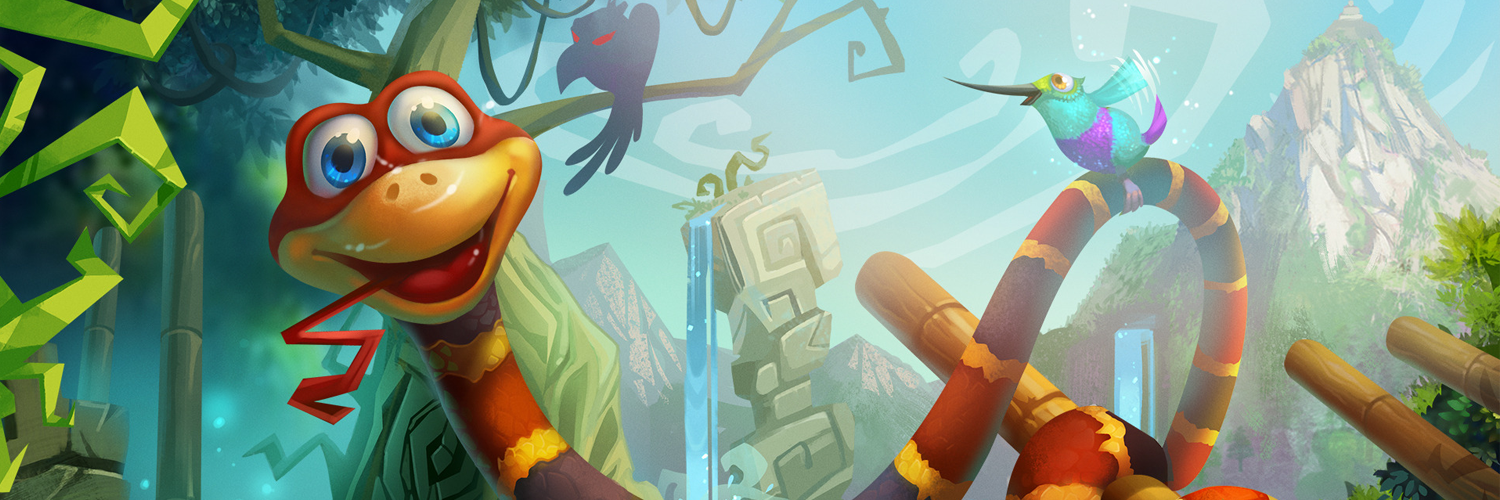
Snake Pass PC Review
I think it’s pretty fair to say there is nothing quite like Snake Pass, with respect to the control scheme at least. I mean, it’s a platformer where you take on the role of a snake – manoeuvring around obstacles by coiling around them and then stiffly edging out to hoist up and around the next one. Where you have to slither left and right to gain speed and squeeze around levers to pull them and so on. In fact, there’s quite a heavy focus on these unique platforming mechanics but I guess that works in its favour because unfortunately that is really all Snake Pass has to offer in terms of gameplay. The story is paper-thin, going into no more detail than ‘some magical gems that are used to power portals have been knocked all over the place; find and replace them’. Even then that would normally be fine – we don’t need a reason for everything we do in games, such as running to the right and stomping Goombas, but usually games like that instead provide a challenge as the motivational tool that keeps us going. Sadly, Snake Pass fails to deliver there too.
It starts off fun and interesting as you slither around the colourful, simple levels, collecting everything in sight and learning how to climb the few different types of obstacles in your path, but pretty soon you’ve seen it all before and the climbing doesn’t ever get much harder, even across the 4 worlds (earth, water, fire, and air). True, it begins to look a little more dangerous but it’s still all about one simple flow – move a little, coil, move a little, coil. Patience is all it takes and although you want to just dash across the poles and over the gap as you normally would in a platformer, the only hard part is to force yourself to slow down and wrap around the obstacles every few inches to stabilise. Once that built-in need to rush has been restrained the game becomes a cakewalk, albeit with one exception – moving obstacles. And to be honest these do seriously up the difficulty curve but only because the camera becomes uncontrollable and it’s impossible to know what’s going on. Manipulating the protagonist three-dimensionally around a spinning obstacle, often with no shadows to depict the location (as you’re in the air) and not being able to see anything due to the obstructed camera is just a nightmare.

And the camera wasn’t the only thing I had trouble with either – a good few times when Doodle the snake’s head didn’t bang off of a wall as I tried to thread it through a gap, it instead glitched through some bamboo scaffold and I fell to my death. Still though, as annoying as these issues were, the experience overall was fairly decent. The 6 hours or so it takes to 100% the game, however short it may sound, I feel are just about right so as not to overstay its welcome whilst still getting the point across and allowing the player to explore what the game has to offer. It’s certainly not life-changing, nor does it have any kind of meaningful interaction, but it’s a neat way to kill some time and try something new. And it did leave me curious to know what else could be included to challenge the player if the developers had delved any deeper, especially since the ending was left open to allow for a sequel, unfortunately with an anticlimactic cutscene and not any sort of boss fight or final hoorah, though.
And that’s all there really is to say about Snake Pass as it’s such a simple, easy game at its core. The controls are intriguing enough to hook a player in and it’s quite fun to embrace the elementary mastery of them once they’ve become second nature and platforming through formidable-looking obstacle courses is a breeze. Plus, relaxedly exploring the 15 stages for collectibles (20 wisps and 5 coins per level) is made more enjoyable by the charming, bright design and chilled out tunes that accompany it, which is all it really aims to be – a laid back game that shows off a new angle for a bit of fun. No real replayability after the few collectibles or big skill wall to overcome, or even any kind of lesson to learn, but instead to almost act as a kind of sandbox for a new type of control system and whilst it could have been built on, it does do what is set out to do, just a bit lazily.
